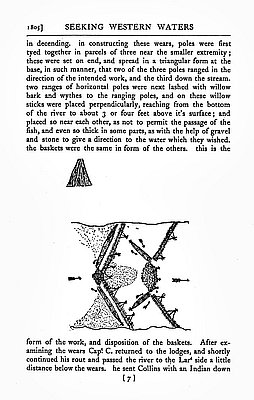- Catalog No. —
- Oregon Argus, November 24, 1860
- Date —
- November 24, 1860
- Era —
- 1846-1880 (Treaties, Civil War, and Immigration)
- Themes —
- Government, Law, and Politics, Native Americans, Oregon Trail and Resettlement, Transportation and Communication
- Credits —
- Oregon Historical Society
- Regions —
- Northeast Oregon Trail
- Author —
- Oregon Argus
Snake River Massacre Account by One of the Survivors
This article was published in the Oregon Argus on November 24, 1860. It recounts the experiences of Joseph Myers, one of the survivors of the worst massacre of overland emigrants by Indians in the history of the American West, the Utter-Van Ornum Massacre.
Contrary to cinematic depictions of Indian-white relations along the Oregon Trail, sustained attacks by Indians on emigrant wagon trains were rare. Although conflict did occur, historian John Unruh notes that “thievery and not murderous attack constituted the major threat posed by Indians.” In fact, mutual aid between Indians and overlanders was much more common than violent hostility.
However, as the number of emigrants crossing the Oregon Trail increased over the course of the 1850s, Indian-white relations deteriorated. Unruh estimates that just over 360 emigrants were killed by Indians from 1840 to 1860, most of them during the 1850s. In comparison, he estimates that more than 425 Indians were killed by emigrants during the same period. The great majority of these violent conflicts occurred west of the Rockies, which was by far the most dangerous portion of the overland journey.
The first major massacre of emigrants by Indians occurred along the Snake River in 1854 when nineteen overlanders were slaughtered by Shoshone Indians in what came to be known as the Ward Massacre. Six years later, the Snake River country would witness another attack, the Utter-Van Ornum Massacre.
The Utter-Van Ornum party left Wisconsin in May 1860, most heading for Oregon’s Willamette Valley. The wagon train—which consisted of eighteen men, five women, twenty-one children, twelve wagons, and one hundred head of livestock—arrived at the abandoned Fort Hall on August 21, 1860, encountering no major difficulties along the way. A company of U.S. Army dragoons had been stationed near the fort earlier that year to escort wagon trains through the Snake River country, but they escorted the Utter-Van Ornum party for only six days, purportedly because the commanding officer was upset with members of the train.
About ten days after parting from the dragoon escort, the Utter-Van Ornum train was attacked by approximately one hundred Indians, probably a mixed group of Shoshone and Bannock, perhaps accompanied by several white men. The attack and its aftermath are described in detail in the accompanying newspaper article.
Eleven emigrants were killed during the first two days, after which the survivors abandoned their wagons and fled, splitting into several groups. The Van Ornums and three other emigrants were later killed in mid-October near present-day Huntington. Another group stayed along the Owyhee River, where they slowly starved. Five of the emigrants, four of them children, died while waiting for rescue, and the survivors were forced to eat the remains. They were finally rescued by the U.S. Army forty-five days after the initial attack. Of the original forty-four members of the Utter-Van Ornum party, only sixteen survived, including one of the Van Ornum children who was rescued from the Shoshone two years later.
Further Reading:
Shannon, Donald H. The Utter Disaster on the Oregon Trail: The Utter and Van Ornum Massacres of 1860. Caldwell, Idaho, 1993.
Unruh, John D., Jr. The Plains Across: The Overland Emigrants and the Trans-Mississippi West, 1840-60. Urbana, Ill., 1979.
Written by Cain Allen © Oregon Historical Society, 2005.

